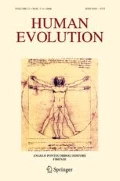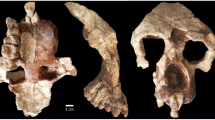Abstract
For a long time, French scientists have been involved in the study of human evolution and especially of human origins. Their key works in Eastern Africa have led to the discovery of major fossil hominid sites, especially in the Afar region in Ethiopia, where numerous remains ofAustralopithecus afarensis have been unearthed. The major contribution of the French scholars to the interpretation of the Hadar sample was to demonstrate the impact of the postcranial features on taxonomy and phylogeny. Two groups were identified in the sample and by comparison with modern populations of wild primates, these groups are assigned to different taxa. The other major impact was to show that early hominid bipedalism was an exact replica of modern human bipedality.
Similar content being viewed by others
References
Arambourg C., Chavaillon J. & Coppens, Y., 1967.Expédition internationale de recherches paléontologiques dans la vallée de l'Omo (Ethiopie) en 1967. Congrès Panafricain de Préhistoire, Dakar 1967, 135–140.
Arambourg C. & Coppens, Y., 1967.Sur la découverte dans le Pléistocène inférieur de la vallée de l'Omo (Ethiopie) d'une mandibule d'Australopithécien. Comptes.rendus de l'Académie des Sciences, Paris, 265: 589–590.
Aronson J.L., Schmitt J., Walter R.C., Taieb M., Tiercelin J.J., Johanson D.C. Naeser, C.W. & Nairm A.E.M., 1977.New geochronologic and palaeomagnetic data for the hominid-bearing Hadar Formation of Ethiopia. Nature, 267: 323–327.
Berge C., 1980.Biométrie du bassin des primates. Application aux primates fossiles de Madagascar et aux anciens Hominidés. Thèse de Doctorat 3ème cycle, Université Paris VII.
Berge C. & Ponge, J.F., 1983.Les caractéristiques du bassin des Ausralopithiques (A. robustus, A. africanus et A. afarensis)son elles liées à une bipédie de type humain? Bulletins et Mémoires de la Société d'Anthropologie de Paris, 10: 335–354.
Boaz N.T., Howell, F.C. & Mc Crossin, M.L., 1982.Faunal age of the Usno, Shungura B, and Hadar Formations Ethiopia, Nature, 300: 633–635.
Brown F.H., 1982.Tulu Bor Tuff at Koobi Fora correlated with the Sidi Hakoma Tuff at Hadar. Nature, 300: 631–633.
Coppens Y., 1981.Le cerveau des hommes fossiles. Comptes Rendus de l'Académe des Sciences, Paris, 292, supp. Vie Académique, 3–24.
Coppens Y., 1987.L'homme tertiaire or the earliest possible habilines. Résumés du 2ème Congrès de Paléontologie humaine, table Ronde «Homo habilis», 83–84.
Coppens, Y., Gray, B.T. & Johanson, D.C. 1980.Biostratigraphie d'Hadar comparée à celle des autres gisements plio-pléistocènes est-africains. In (R.E.F. Leakey and B.A. Ogot, eds.). Proceedings of the 8th Panafrican Congress of Prehistory and Quaternary Studies, pp. 56–57. The International Louis Leakey memorial Institute for African Prehistory.
Deloison Y., 1986.Description d'un calcaneum fossile de Primate et sa comparaison avec des calcaneums de Pongidés, d'Australopithèques et d'Homo. Comptes Rendus de l'Académie des Sciences, 302, III: 257–262.
Falk D., 1990.Brain evolution in Homo: the radiator theory. Behavioral and Brain Sciences, 13, 333–381.
Hill A. & Ward, S., 1988.Origin of the Hominidae: the record of African large Hominoid evolution between 14 my and 4 my. Yearbook of Physical Anthropology, 31: 49–83.
Johanson D.C. & Coppens, Y., 1976.A preliminary diagnosis of the first Plio-Pleistocene Hominid discoveries in the Central Afar, Ethiopia. American Journal of Physical Anthropology, 45: 217–234.
Johanson D.C. & Taieb, M., 1976.Plio-Pleistocene hominid discoveries in Hadar, Ethiopia. Nature, 260: 293–297.
Johanson D.C. & White, T.D., 1979.A systematic assessment of early African hominids. Science, 203: 321–329.
Johanson D.C., White, T.D. & Coppens, Y., 1978.A new species of the genus Australopithecus(Primates, Hominidae) from the Pliocene of Eastern Africa. Kirtlandia, 28: 1–14.
McHenry H.M., 1987.Size variation in the postcranium of Australopithecus afarensisand extant species of Hominoidea. Human Evolution, 1 (2): 149–156.
Olson T.R., 1981.Basicranial morphology of the extant hominoids and Pliocene hominids: the new material from the Hadar Formation, Ethiopia and its significance in early human evolution and taxonomy. In (C.B. Stringer ed.). Aspects of human evolution, pp. 99–128. Taylor and Francis Ltd.
Pickford M., 1986.Sex differences in higher primates: a summary statement. In (M. Pickford and B. Chiarelli eds.). Sexual dimorphism in living and fossil primates, pp. 191–199. Il Sedicesimo.
Sarna-Wojcicki, A.M., Meyer, C.E., Roth, P.H. & Brown, F.H., 1985.Ages of tuff beds at East African early hominid sites and sediments in the Gulf of Aden. Nature, 313: 306–308.
Schmid P., 1989.How different is Lucy? In (G. Giacobini ed.). Hominidae, pp. 109–114. Jaca Book.
Senut B., 1978.Contribution à l'étude de l'humérus et de ses articulations chez les Hominidés du Plio-Pléistocène. Thèse de Doctorat 3ème cycle, Université Pierre et Marie Curie, t. I: 104 p.; t II: 50 p.
Senut B., 1986.Long bones of the primate upper limb: monomorphic or dimorphic? Human Evolution, 1 (1): 7–22.
Senut B. & Tardieu, C., 1985.Functional aspects of Plio-Pleistocene hominid limb bones: implications for taxonomy and phylogeny. In (E. Delson ed.). Ancestors: the hard evidence, pp. 193–201, Alan R. Liss Inc.
Senut B. & Tobias, P.V., 1989.A preliminary examination of some new hominid upper limb remains from Sterkfontein (1974–1984). Comptes Rendus de l'Académie des Sciences de Paris, 308, II: 565–571.
Sigmon B.A., 1986.The «head» focus in human palaeontology. In (J. Mlikovsky and V.J.A. Novak, eds.). Evolution and morphogenesis, pp. 635–646, Praha: Academia.
Stern J.T. & Susman, R.L., 1983.The locomotor anatomy of Australopithecus afarensis. American Journal of Physical Anthropology 60: 279–317.
Taieb M., Coppens, Y., Johanson, D.C. & Kalb, J., 1972. Dépots sédimentaires et faunes du Plio-Pléistocène de la basse vallée de l'Awash (Afar central, Ethiopie). Comptes—Rendus de l'Académie des Sciences de Paris, 275, D: 819–822.
Tardieu C., 1979.Analyse morpho-fonctionelle de l'articulation du genou chez les primates. Application aux Hominidés fossiles. Thèse de Doctorat 3ème cycle, Université Pierre et Marie Curie, t. I: 109 p; t. II: 36p.
Tardieu C., 1987.Mise au point d'une nouvelle méthode informatisée d'analyse tridimensionelle de la marche bipède pour l'étude des déplacements des centres de gravité du corps. Application à l'homme et aux primates non humains. Thèse de Doctorat d'Etat, Université Paris VII, t. I: 197 p.; t. II: 106 p.
Tobias P.V., 1989.Hominid variability, cladistic analysis and the place of Australopithecus africanus. In (G. Giacobini ed.), Hominidae, pp. 119–127, Jaca Book.
Tuttle R., 1983. Cited in R. Lewin.Were Lucy's feet made for walking? Science, 220: 700–702.
Tuttle R., 1985.Ape footprints and Laetoli impressions: a response to the SUNY claims. In (P.V. Tobias ed.). Hominid evolution: past, present and future. pp. 129–133, Alan R. Liss Inc.
Walker A.C., Leakey, R.E., Harris, J.M. & Brown, F.H., 1986. 2.5-Myr Australopithecus boiseifrom west of Lake Turkana, Kenya. Nature, 322: 517–522.
Walter R.C. & Aronson, J.L., 1982.Revisions of K/Ar ages for the Hadar hominid site, Ethiopia. Nature, 296: 122–127.
White T.D., 1985.The hominids of Hadar and Laetoli: an element-by-element comparison of the dental samples. In (E. Delson ed.). Ancestors: the hard evidence, pp. 138–152. Alan R. Liss Inc.
Zihlman, A., Cronin, J.E., Cramer, D.L. & Sarich, V.M., 1978.Pygmy chimpanzee as a possible prototype for the common ancestor of humans, chimpanzees and gorillas. Nature, 275: 744–746.
Author information
Authors and Affiliations
Rights and permissions
About this article
Cite this article
Senut, B. French Contribution to the study of Human Origins: The case ofAustralopithecus afarensis . Hum. Evol. 7, 15–24 (1992). https://doi.org/10.1007/BF02436409
Issue Date:
DOI: https://doi.org/10.1007/BF02436409




